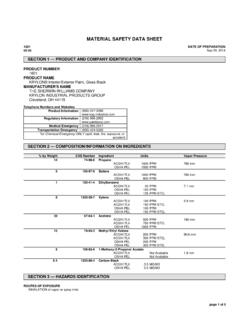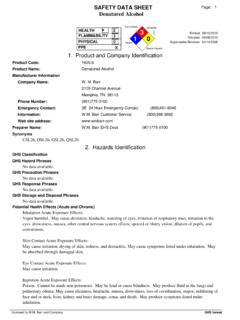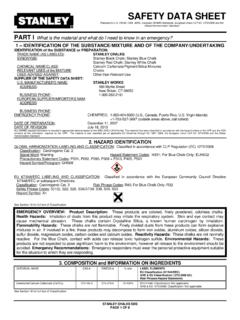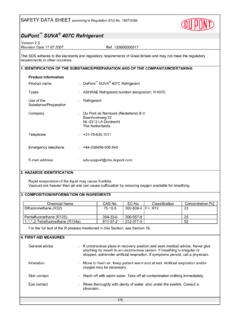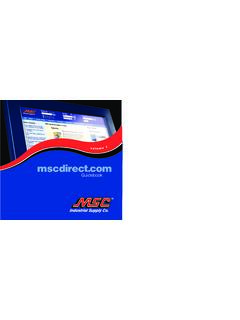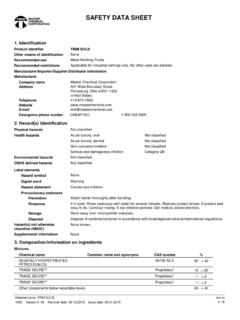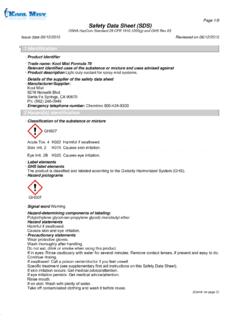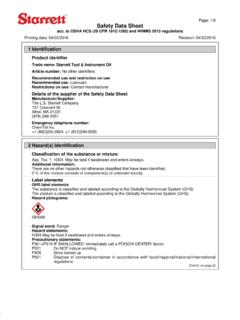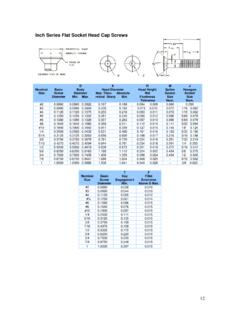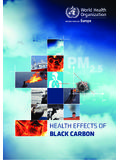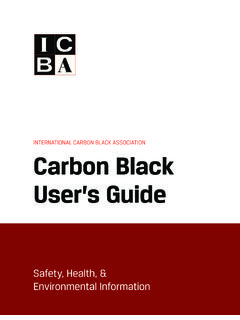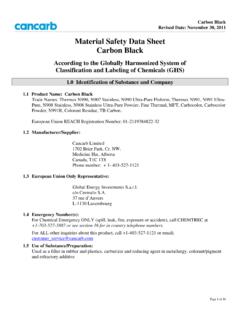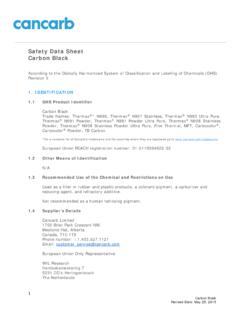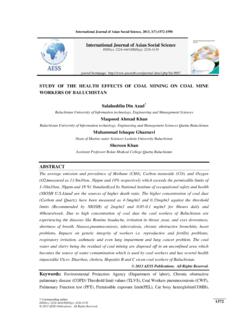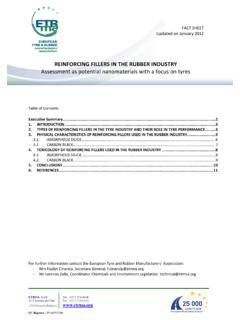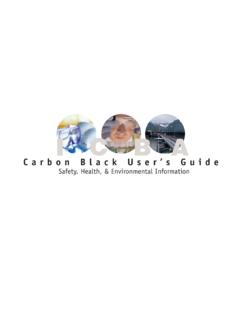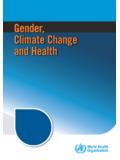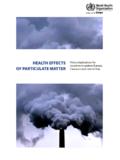Transcription of MATERIAL SAFETY DATA SHEET - MSC Industrial Direct
1 MATERIAL SAFETY data SHEET SANTOPRENE THERMOPLASTIC RUBBER GENERAL PURPOSE GRADES Date Printed: 7/22/08 Page 1 1. CHEMICAL PRODUCT AND COMPANY IDENTIFICATION ADVANCED ELASTOMER SYSTEMS, EMERGENCY TELEPHONE NUMBERS 388 South Main Street (CHEMTREC) Akron, Ohio 44311 In the U. S. call 1-800-424-9300 Outside the US call collect 1-703-527-3887 Product Identification: 101-55 101-73W175 201-55 201-73W175 101-55W175 101-80 201-55W175 201-80 101-64 101-87 201-64 201-87 101-64W175 103-40 201-64W175 203-40 101-73 103-50 201-73 203-50 2.
2 COMPOSITION/INFORMATION ON INGREDIENTS Santoprene thermoplastic rubber grades are proprietary products. Their composition is trade secret infor-mation of Advanced Elastomer Systems, These products are not identified by CAS number. All compo-nents of these products appear on the Inventory of Chemical Substances published by the Environmental Protection Agency or qualify for the TSCA polymer exemption under Federal Register Vol. 60, No. 60, 3/29/95. New Jersey Trade Secret Registry No.: 01122800003-5001P. Airborne Exposure Limits Weight Components: CAS. NO. OSHA PEL ACGIH PEL Percent Thermoplastic rubber Mixture None established None established 100% Components within Polymer Matrix: Carbon black 1333-86-4 mg/m3 TWA mg/m3 0 to 3% Black grades contain carbon black, CAS No.
3 1333-86-4, within the polymer matrix. The International Agency for Research on Cancer (IARC) has determined that carbon black is possibly carcinogenic to humans (IARC Group 2B). IARC determined that there is inadequate evidence in humans but sufficient evidence in experi-mental animals for carcinogenicity of carbon black. 3. HAZARDS IDENTIFICATION Emergency Overview: HANDLE PELLETS IN ACCORDANCE WITH GOOD Industrial HYGIENE AND SAFETY PRACTICES. THESE PRACTICES INCLUDE AVOIDING UNNECESSARY EXPOSURE AND REMOVAL OF THE MATERIAL FROM EYES, SKIN AND CLOTHING. CAUTION! PROCESSING RELEASES VAPORS OR FUMES WHICH MAY CAUSE RESPIRATORY TRACT IRRITATION.
4 Avoid breathing processing fumes or vapors. Process using adequate ventilation. Potential Health Effects: INHALATION: Inhalation of fumes or vapors during processing may cause respiratory tract irritation. EYE CONTACT: Pellets do not cause significant eye irritation. SKIN CONTACT: Pellets do not cause significant skin irritation. 4. FIRST AID MEASURES INHALATION: If fumes are inhaled, remove to fresh air. If breathing is difficult, get medical attention. 5. FIRE FIGHTING MEASURES Flash (piloted) Ignition Temperature: >650 F (343 C) Method: ASTM D 1929-77 Self-Ignition (non-piloted) Temperature: >700 F (371 C) Method: ASTM D 1929-77 Extinguishing Media: Water spray or any Class A extinguishing agent.
5 MATERIAL SAFETY data SHEET SANTOPRENE THERMOPLASTIC RUBBER GENERAL PURPOSE GRADES Date Printed: 7/22/08 Page 2 Special Firefighting Procedures: Firefighters and others exposed to products of combustion should wear self-contained breathing apparatus and full protective clothing. Carbon monoxide is liberated as a toxic decompo-sition product when Santoprene general purpose thermoplastic rubber is ignited. Unusual Fire and Explosion Hazards: None known. Static Generation: Pneumatic transfer of plastic pellets can generate large static discharges which could cause an incendiary electrostatic spark. Excessive transfer also causes dust which can be ignited under some conditions. Take proper precautions when transferring Santoprene thermoplastic rubber, including ground-ing all equipment, providing an inert atmosphere and properly designing MATERIAL handling equipment, to pre-vent electrostatic charge formation.
6 6. ACCIDENTAL RELEASE MEASURES Spilled product may cause a slipping hazard. IN CASE OF SPILL OR LEAK, vacuum or sweep up and place in clean, covered containers for recycle or dis-posal. 7. HANDLING AND STORAGE Avoid leaving container open for prolonged periods to prevent exposure to humidity. Santoprene general purpose thermoplastic rubber will pick up small amounts of moisture. Store in a cool, dry place. Usual pre-cautions in pellet handling should be observed to prevent contamination by dirt or other materials. 8. EXPOSURE CONTROLS/PERSONAL PROTECTION Eye Protection: Santoprene general purpose thermoplastic rubber does not cause significant eye irritation or eye toxicity requiring special protection.
7 Use good Industrial practice to avoid eye contact. Skin Protection: Although Santoprene general purpose thermoplastic rubber does not present significant skin concern; minimize skin contamination by following good Industrial hygiene practice. Wearing protective gloves is recommended. Wash hands and contaminated skin thoroughly after handling. Respiratory Protection: Avoid breathing process vapors or dust. Use NIOSH approved respiratory protection equipment (full facepiece recommended) when airborne exposure is excessive. Consult respirator manufac-turer to determine appropriate type equipment for given application. Observe respirator use limitations speci-fied by NIOSH or the manufacturer.
8 Respiratory protection programs must comply with 29 CFR Ventilation: Provide natural or mechanical ventilation to minimize exposure. If practical, use local mechanical exhaust ventilation at sources of air contamination such as open process equipment. 9. PHYSICAL AND CHEMICAL PROPERTIES Appearance: Black or natural (colorable) pellets. Odor: Slightly rubberlike. Specific Gravity: to Hardness: 55 Shore A to 50 Shore D NOTE: These physical data are typical values based on MATERIAL tested but may vary from sample to sample. Typical values should not be construed as a guaranteed analysis of any specific lot or as specifications for the product. 10. STABILITY AND REACTIVITY Stability: Thermally stable to 500 F (260 C).
9 Materials to Avoid: Santoprene thermoplastic rubber may react with strong oxidizing chemicals. Santo-prene thermoplastic rubber also reacts with acetal resins at temperatures of 425 F (218 C) and above, pro-ducing decomposition of the acetal resin, and formaldehyde as a decomposition product. Decomposition of halogenated polymers and phenolic resins may also be accelerated when they are in contact with Santo- MATERIAL SAFETY data SHEET SANTOPRENE THERMOPLASTIC RUBBER GENERAL PURPOSE GRADES Date Printed: 7/22/08 Page 3 prene thermoplastic rubber at processing temperatures. Thoroughly purge processing equipment with poly-olefin polymers, including polypropylene, when using the same equipment to process Santoprene thermo-plastic rubber and acetal resins, halogenated polymers and phenolic resins.
10 Do not mix Santoprene ther-moplastic rubber, acetal resins, halogenated polymers or phenolic resins at elevated temperatures. Hazardous Decomposition Products: Smoke, carbon monoxide and possibly hydrocarbons may evolve when processing temperatures exceed 500 F (260 C) or when Santoprene general purpose thermoplastic rubber is ignited. Hazardous Polymerization: Does not occur. 11. TOXICOLOGICAL INFORMATION The following information summarizes human experience and results of scientific investigations reviewed by health professionals for hazard evaluation of Santoprene general purpose thermoplastic rubber and devel-opment of Precautionary Measures and Occupational Control Procedures recommended in this document.
